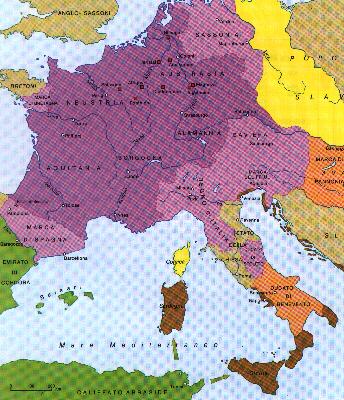| In the VI and VII century Ivrea was a Longobard duchy that stretched between the
rivers Orco and Sesia, and it included, to the South some hills of Monferrato. The
Longobard domination was followed by the Francs’: In 754, in fact, Pipino il Breve,
The Francs’ king |
|
defeated Astolfo, king of the Longobards, near Ivrea: Thus Ivrea became part of the Sacred Roman Empire of Charlemagne (see the picture) who came to Ivrea on the 24th of June 801. Charlemagne organized his great empire through a feudal system: the territory was thus divided into feuds called counties or "marche" (several counties together) allotted to a Signore (the feudatory) who controlled it on behalf of the king or of the emperor. In this period
Ivrea was the main centre of a very important county so much so that Charlemagne’s successor, his son Lodovico
started a “studium”( the equivalent to a University), run by the bishop. In this studium it was possible to study the liberal arts of the trivium (Grammar, Rhetoric, Dialectics) and of the quadrivium (Arithmetic, Geometry, Music, Astronomy). After the death of Lodovico, the Holy Roman Empire began to disintegrate. Ivrea was part of the Kingdom of Italy ( which included Northern Italy and part of Tuscany) that belonged to Lothair who, despite |
|
| the fact he was the Emperor, had less and less power over the feudatories who,
moreover, had acquired hereditary rights on their feuds. |
|
